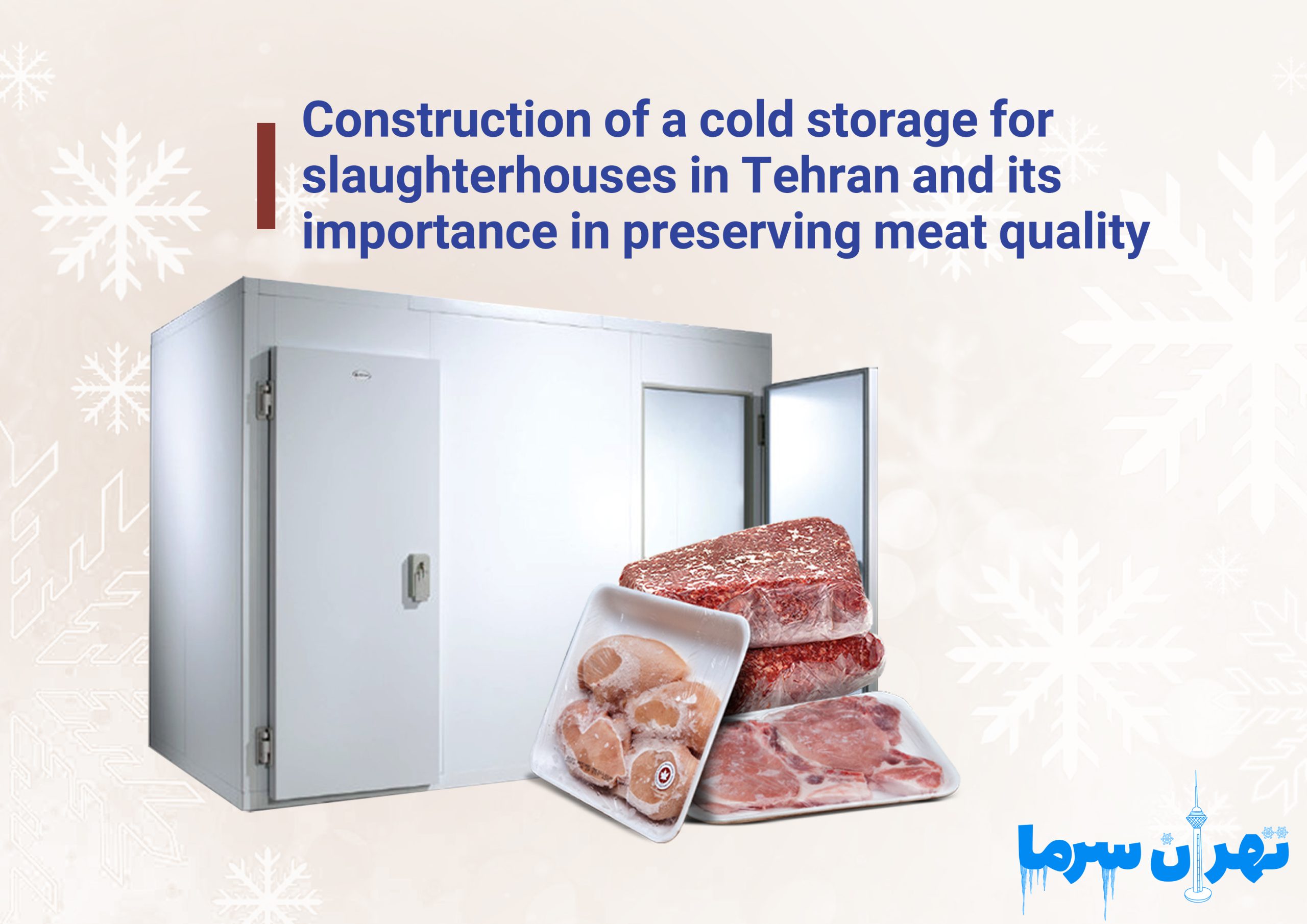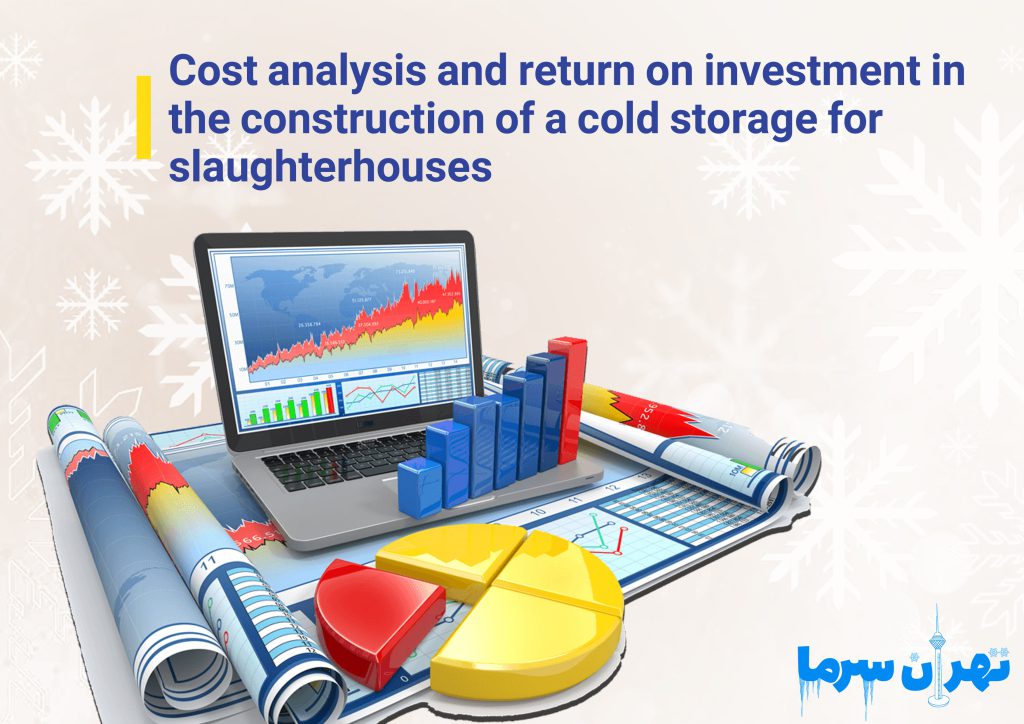Construction of Cold Storage for Slaughterhouses in Tehran and Its Importance in Preserving Meat Quality

Construction of Cold Storage for Slaughterhouses: A Necessity for Meat Quality Preservation
Building cold storage for slaughterhouses is essential to maintaining meat quality and preventing spoilage. The establishment of cold storage must consider storage capacity, refrigeration systems, and health standards. In Tehran, where the demand for advanced meat preservation facilities is high, slaughterhouse cold storage is built using modern equipment and proper insulation.
Cold Storage for Slaughterhouses and Meat Quality Preservation
One of the most significant advantages of cold storage is maintaining meat quality. Due to its specific composition, meat quickly deteriorates under improper conditions and high temperatures. By using cold storage, meat temperature is controlled during storage, preventing bacterial and microorganism growth.
This process not only prevents spoilage but also helps preserve the taste and nutritional value of meat. Cold storage allows meat to remain fresh for extended periods, making it easier to distribute to markets and reach consumers.
Cold Storage for Slaughterhouses and Public Health Assurance
Moreover, constructing cold storage for slaughterhouses in Tehran is crucial for public health. Without standard cold storage, slaughtered meat may be exposed to unsuitable environmental conditions, increasing the risk of contamination and zoonotic diseases (diseases transmitted between animals and humans).
By establishing high-quality cold storage that meets health standards, meat can be safely preserved, ensuring public safety and reducing health risks.
Cold Storage Construction for Slaughterhouses in Tehran
Additionally, considering cold storage for slaughterhouses, especially in Tehran, where meat consumption is higher than in other Iranian cities, can improve market supply and demand.
With cold storage, large quantities of meat can be stored for extended periods and supplied to the market during peak demand, such as holidays and special occasions. This not only reduces meat waste but also helps regulate prices and stabilize meat supply chains.
The Importance of Proper Insulation in Cold Storage Construction for Slaughterhouses to Reduce Energy Loss
Choosing the right insulation in cold storage construction is a fundamental factor in achieving high energy efficiency and maintaining optimal internal temperatures. Refrigeration in cold storage typically requires a significant amount of energy.
If a cold storage facility is not properly insulated, a large amount of the generated cooling energy is lost, as cold air easily escapes through the walls, ceiling, and floor. This not only increases operational costs but also reduces the storage facility’s efficiency.
By selecting high-quality insulation, heat transfer between the cold storage interior and the external environment can be minimized. Insulation acts as a thermal barrier, preventing external heat from entering or internal cold from escaping, thereby reducing long-term energy consumption. This is particularly crucial for slaughterhouses, where meat preservation must be continuous at a stable temperature.
When choosing the right insulation, factors such as insulation type, thermal conductivity, moisture resistance, durability, and compatibility with industrial environments should be considered. For example, polyurethane and polystyrene insulations are widely used in cold storage due to their low thermal conductivity and high resistance to harsh environmental conditions.
Additionally, these insulations are cost-effective and significantly reduce operational expenses.
Beyond technical specifications, selecting appropriate insulation for slaughterhouse cold storage must be based on the facility’s specific needs. Factors such as humidity levels, production processes, required meat storage temperatures, and even external environmental conditions, such as outdoor temperature and sun exposure, must be considered.
For instance, in tropical regions or during hot summer months, using heat- and moisture-resistant insulation can enhance cold storage efficiency and prevent energy loss.
However, choosing the right insulation alone is not enough. Proper maintenance and operation of cold storage facilities also play a key role in optimizing energy consumption.
Regular inspections of insulation joints, ensuring the integrity of doors and sealing systems, and monitoring refrigeration system performance can prevent energy loss and ensure optimal cold storage operation.
Examining the Impact of Sandwich Panel Thickness on Thermal Performance in Cold Storage Construction for Slaughterhouses
Sandwich panels are composed of two outer layers made from materials such as galvanized steel, aluminum, or polymer sheets, with a central insulating layer typically made of polyurethane, polystyrene, or other insulating materials.
Due to their unique structure, these panels effectively prevent heat transfer, creating optimal conditions for storing sensitive products like meat. However, the thickness of these panels is a crucial factor to consider.
The thickness of sandwich panels directly impacts the thermal performance of cold storage, particularly in slaughterhouses. The thicker the insulating layer, the lower the heat conductivity. As a result, thicker sandwich panels are more effective at preventing heat from entering or cold from escaping the storage unit.
This feature is especially important for slaughterhouses, where maintaining a stable and controlled temperature over long periods is essential. By using appropriately thick sandwich panels, the desired internal temperature can be maintained, preventing sudden temperature fluctuations that could lead to meat spoilage.
In addition to affecting thermal performance, sandwich panel thickness also impacts energy consumption. In slaughterhouse cold storage facilities, refrigeration systems operate continuously to maintain a specific temperature range.
If the panels are not adequately insulated, the refrigeration system will need to consume more energy to maintain a stable cold storage temperature. By selecting sandwich panels with appropriate thickness, energy consumption is significantly reduced, as these panels prevent heat loss and cooling inefficiencies.
This contributes to improving the efficiency of the refrigeration system and lowering operational costs. Additionally, it can help reduce the environmental impact caused by excessive energy consumption.
Furthermore, panel thickness plays a significant role in the longevity of the structure. Thicker sandwich panels generally offer higher resistance to mechanical damage and environmental conditions. These features make the panels more durable against external pressures, such as impacts during transportation or loading.
This aspect is especially crucial in slaughterhouses, where industrial and high-stress environments are prevalent. By choosing sandwich panels of suitable thickness, physical damage to the cold storage structure can be prevented, thereby extending its service life.
Designing and Constructing a Cold Storage Facility for Slaughterhouses with IQF Rapid Freezing
Designing and constructing a cold storage facility for slaughterhouses with rapid freezing capabilities is one of the most critical steps in preserving meat and other protein products. These cold storage units utilize rapid freezing technology to freeze meat at extremely low temperatures quickly, preserving its texture and quality while preventing bacterial growth.
In slaughterhouses, meat must reach freezing temperatures as quickly as possible after slaughter to prevent spoilage. IQF cold storage facilities, equipped with advanced refrigeration systems and proper ventilation, enable meat to be frozen rapidly and stored under safe and hygienic conditions for extended periods.
This process helps maintain the flavor, color, and nutritional value of the meat while increasing its shelf life. In slaughterhouses, implementing such advanced systems enhances efficiency, reduces waste, and improves overall distribution processes.
Cost Analysis and Return on Investment in Building a Slaughterhouse Cold Storage Facility
Conducting a cost analysis and return on investment (ROI) assessment in building a cold storage facility for slaughterhouses is a crucial step in decision-making, helping slaughterhouse owners evaluate the economic feasibility of such projects. The construction costs of a cold storage facility include expenses such as purchasing building materials, refrigeration equipment, installing cooling systems, insulation, and initial operational costs like electricity and labor.
However, investing in these projects can yield significant long-term benefits, as they help preserve meat quality and reduce waste, allowing meat to be stored and distributed under optimal conditions for extended periods.
Additionally, by utilizing advanced cold storage solutions, slaughterhouses can expand their storage capacity, ultimately enhancing their production volumes. With a thorough cost analysis and ROI estimation, slaughterhouses can accurately calculate the profitability of these projects and make well-informed decisions regarding investment amounts and payback periods.
Why Choose Tehran Sarma Engineering for Building a Slaughterhouse Cold Storage Facility
Selecting Tehran Sarma Engineering as the ideal choice for building a slaughterhouse cold storage facility is recommended for several reasons. With extensive experience and expertise in designing and constructing industrial cold storage units—particularly those for slaughterhouses—this company effectively identifies and meets the industry’s specific and complex requirements.
Tehran Sarma utilizes state-of-the-art equipment and the latest global technologies to deliver highly efficient refrigeration systems that reduce energy costs and enhance the performance of cold storage facilities. Additionally, its team of specialists and technical consultants provide detailed guidance and customized designs tailored to each slaughterhouse’s unique needs, ensuring optimal meat and protein product preservation.
Other advantages of choosing Tehran Sarma include guaranteed quality, timely project execution, and professional after-sales services, making it a reliable choice for constructing slaughterhouse cold storage facilities.
For more information on the cost of building various types of cold storage facilities, visit the Tehran Sarma website or contact 09121906418 and 02177972256.
Building a cold storage facility for a slaughterhouse helps extend meat shelf life and ensures compliance with hygiene regulations. Therefore, constructing such facilities should involve advanced equipment and efficient refrigeration systems. In particular, establishing slaughterhouse cold storage in Tehran, due to the high concentration of meat supply centers, requires adherence to specific standards to maintain product quality and minimize waste.
Source:
https://unitedinsulated.com/




 سردخانه
سردخانه برق
برق کمپرسور
کمپرسور کمپرسور بیتزر
کمپرسور بیتزر کمپرسور کوپلند
کمپرسور کوپلند کمپرسور بوک
کمپرسور بوک کمپرسور دانفوس
کمپرسور دانفوس کمپرسور منیروپ دانفوس
کمپرسور منیروپ دانفوس کمپرسور امبراکو
کمپرسور امبراکو کمپرسور پاناسونیک
کمپرسور پاناسونیک کمپرسور سابکول
کمپرسور سابکول کمپرسور کوپلند
کمپرسور کوپلند کمپرسور اسکرال کوپلند
کمپرسور اسکرال کوپلند کمپرسورفراسکلد
کمپرسورفراسکلد کمپرسور رفکامپ
کمپرسور رفکامپ کمپرسور اسکرال دانفوس
کمپرسور اسکرال دانفوس گاز مبرد
گاز مبرد گاز R22
گاز R22 گاز R134
گاز R134 گاز R404
گاز R404 گاز R407
گاز R407 گاز R410
گاز R410 گاز R508
گاز R508 کندانسور هوایی
کندانسور هوایی اواپراتور
اواپراتور اواپراتور آرشه
اواپراتور آرشه اواپراتور صابکول
اواپراتور صابکول اواپراتور آسه
اواپراتور آسه اواپراتور نیک
اواپراتور نیک اواپراتور آرتک
اواپراتور آرتک اواپراتور نوین
اواپراتور نوین اواپراتور تبادل کار
اواپراتور تبادل کار درب
درب ساندویچ پنل
ساندویچ پنل فن سردخانه
فن سردخانه روغن کمپرسور سانیسو
روغن کمپرسور سانیسو متعلقات سردخانه
متعلقات سردخانه